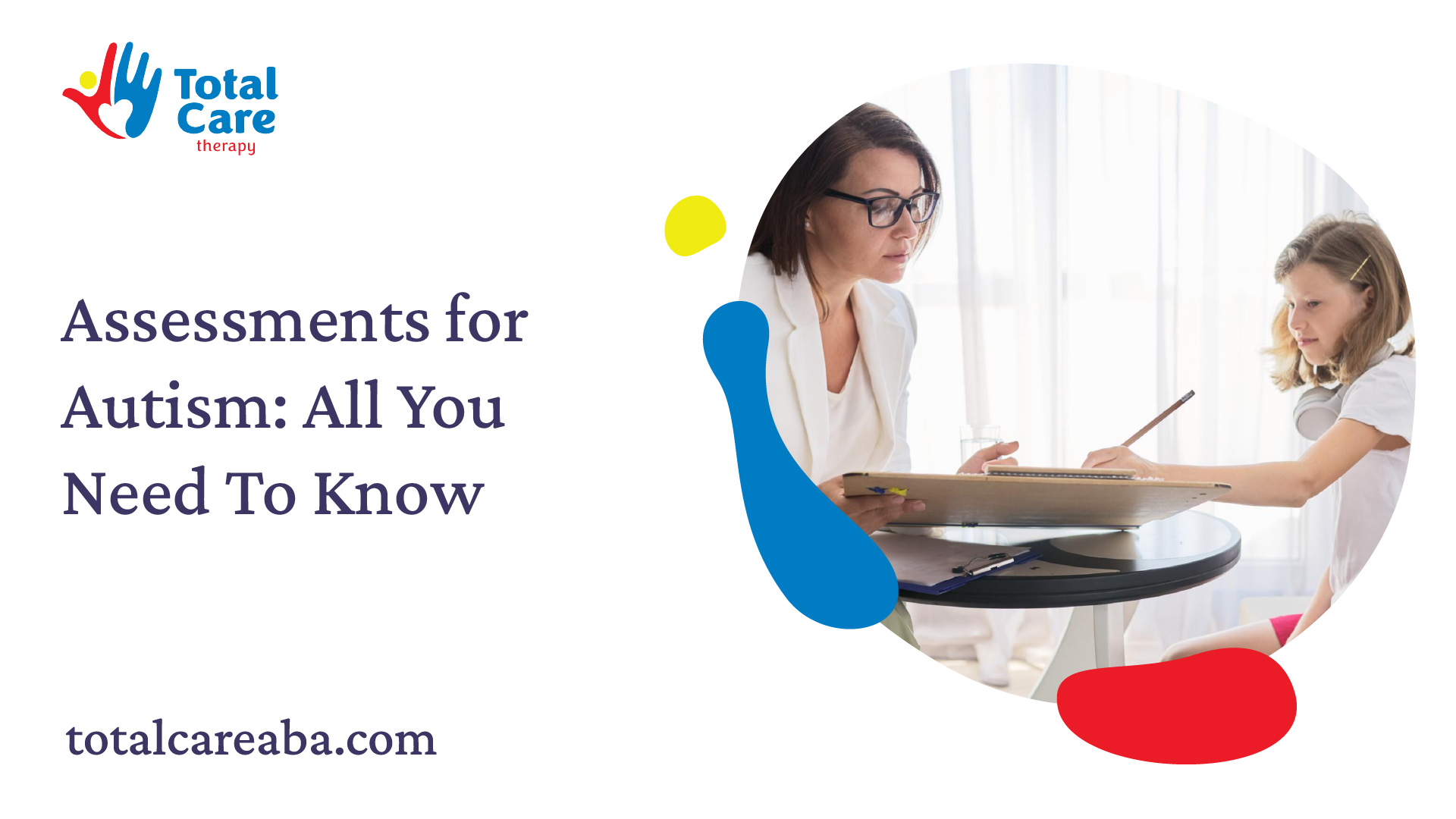Assessments for Autism: All You Need To Know
An assessment for autism is a comprehensive evaluation that helps to identify and diagnose autism spectrum disorder (ASD). This evaluation is typically carried out by a qualified healthcare professional, such as a pediatrician, psychologist, or psychiatrist.
Assessments for Autism: All You Need To Know
Understanding Autism Assessments
For parents seeking an autism diagnosis for their child, understanding the process of diagnostic assessments is crucial. These assessments play a vital role in identifying and understanding autism spectrum disorder (ASD). This section will delve into the importance of diagnostic assessments for autism and what parents can expect during the assessment process.
Importance of Diagnostic Assessments for Autism
Diagnostic assessments for autism are essential for several reasons. Firstly, they provide a comprehensive evaluation of a child's developmental and behavioral patterns, helping healthcare professionals determine whether the child meets the criteria for an autism diagnosis.
By conducting these assessments, healthcare providers can gather the necessary information to develop an appropriate intervention plan tailored to the child's specific needs.

Furthermore, diagnostic assessments for autism help differentiate ASD from other developmental conditions. This distinction is crucial, as it guides treatment strategies and enables early intervention, which can have a significant impact on a child's development and quality of life.
Additionally, an accurate autism diagnosis allows access to specialized services, support groups, and community resources that can assist both the child and their family.
What to Expect During an Autism Assessment
During an autism assessment, parents can expect a thorough evaluation of their child's developmental, medical, and behavioral history. The assessment process typically involves several components, which may vary depending on the healthcare provider and the specific assessment tool used.
- Medical History and Physical Examination: The healthcare provider will gather information about the child's medical history, including any prenatal, birth, or early developmental factors that could contribute to autism. A physical examination may also be conducted to rule out any underlying medical conditions.
- Developmental History: Parents will be asked about their child's developmental milestones, such as language acquisition, social interactions, and play skills. This information helps establish a comprehensive picture of the child's developmental trajectory.
- Observation and Behavioral Assessments: The healthcare provider will observe the child's behavior and interactions. This may involve structured activities, play-based assessments, or standardized questionnaires completed by parents or caregivers. These assessments help evaluate social communication skills, repetitive behaviors, and sensory sensitivities.
The specific assessment tools used may vary, but some commonly employed ones include:
By understanding the importance of diagnostic assessments for autism and having an idea of what to expect during the assessment process, parents can be better prepared to navigate this journey.
Seeking the guidance of healthcare professionals experienced in diagnosing autism and collaborating with them throughout the assessment process can provide valuable insights and support for both the child and their family.
Types of Diagnostic Assessments
When it comes to diagnosing autism, there are several types of diagnostic assessments that professionals may use to gather information and make an accurate evaluation.
These assessments play a crucial role in identifying the presence of autism and determining appropriate interventions and support. Let's explore three common types of diagnostic assessments for autism: developmental screening, comprehensive diagnostic evaluation, and autism-specific assessments.
Developmental Screening
Developmental screening is an initial step in identifying potential developmental delays or concerns. It involves a brief assessment to determine if a child is meeting typical developmental milestones for their age. While developmental screening does not provide a definitive autism diagnosis, it helps to identify children who require further assessment for possible autism spectrum disorder (ASD).
Developmental screening tools often involve standardized questionnaires or checklists that parents, caregivers, and professionals complete. These tools assess various developmental domains, such as communication, social skills, and behavior. If concerns are identified during developmental screening, a comprehensive diagnostic evaluation is typically recommended.
Comprehensive Diagnostic Evaluation
A comprehensive diagnostic evaluation is a more in-depth assessment that aims to gather detailed information about a child's developmental and behavioral characteristics. This evaluation involves a multidisciplinary approach, typically involving professionals from various disciplines, such as psychology, psychiatry, speech-language pathology, and occupational therapy.
During a comprehensive diagnostic evaluation, professionals gather information through interviews with parents or caregivers, direct observation of the child's behavior, and standardized assessments.
These assessments may include cognitive testing, language and communication assessments, and social and behavioral evaluations. The evaluation process often takes into account the child's developmental history, medical history, and family history.
Autism-Specific Assessments
Autism-specific assessments are specifically designed to evaluate the presence and severity of autism spectrum disorder. These assessments focus on the core symptoms and characteristics associated with autism and provide valuable information for diagnosis and treatment planning.
There are several autism-specific assessments widely used by professionals. Let's explore three common ones:
- Autism Diagnostic Observation Schedule (ADOS): ADOS is a standardized assessment that involves direct interaction and observation of the individual being evaluated. It includes various activities and scenarios designed to elicit specific behaviors associated with autism. ADOS provides a structured framework for assessing communication, social interaction, play, and imaginative use of materials.
- Childhood Autism Rating Scale (CARS): CARS is a behavior rating scale that assesses the presence and severity of autism symptoms. It involves direct observation of the individual's behavior and interaction, as well as interviews with parents or caregivers. CARS provides a quantitative score that helps professionals determine the likelihood of an autism diagnosis.
- Social Communication Questionnaire (SCQ): SCQ is a questionnaire completed by parents or caregivers. It is designed to screen for possible autism spectrum disorder. The SCQ includes questions about the child's social communication skills, repetitive behaviors, and restricted interests.
These autism-specific assessments, along with developmental screening and comprehensive diagnostic evaluation, contribute to a comprehensive assessment process for autism spectrum disorder. They provide valuable information that helps professionals make an accurate diagnosis and develop appropriate interventions and support plans for individuals with autism.
Components of Autism Assessments
To accurately diagnose autism spectrum disorder (ASD), comprehensive assessments are conducted. These assessments typically consist of various components that provide valuable information about the individual being evaluated. The key components of autism assessments include medical history and physical examination, developmental history, and observation and behavioral assessments.
Medical History and Physical Examination
A crucial component of autism assessments is obtaining a detailed medical history and conducting a physical examination. This helps rule out any underlying medical conditions that may contribute to the individual's symptoms or affect their development.
The medical history may involve discussions about the individual's prenatal, birth, and early developmental period, as well as any medical conditions or genetic factors that could be relevant.
During the physical examination, the healthcare professional evaluates the individual's physical characteristics, such as facial features, body proportions, and any physical abnormalities that may be associated with certain genetic conditions. The medical history and physical examination provide valuable insights into the individual's overall health and help guide the diagnostic process.
Developmental History
Another important component of autism assessments is the developmental history. This involves gathering information about the individual's early milestones, such as motor skills, language development, social interactions, and cognitive abilities.
The developmental history may include discussions with parents or caregivers, review of early childhood records, and standardized questionnaires to assess developmental milestones.
By understanding the individual's developmental trajectory, healthcare professionals can identify any delays or atypical patterns that may be indicative of autism spectrum disorder. The developmental history helps establish a comprehensive picture of the individual's developmental profile and aids in the diagnostic process.
Observation and Behavioral Assessments
Observation and behavioral assessments play a critical role in autism assessments. Healthcare professionals observe the individual's behavior in various settings to assess social interactions, communication skills, repetitive behaviors, and restricted interests. These assessments may involve structured activities, play-based interactions, and direct observations in naturalistic environments.
During the observation and behavioral assessments, healthcare professionals use standardized tools and scoring systems to document and evaluate the individual's behavior. This quantitative data provides objective information that helps in determining whether the individual meets the diagnostic criteria for autism spectrum disorder.
Understanding the components of autism assessments is essential for parents and caregivers seeking a diagnosis for their child. These assessments provide valuable information that helps healthcare professionals make informed decisions and develop appropriate interventions and support strategies.
By collaborating with healthcare professionals, parents can navigate the assessment process and work towards the best outcomes for their child.
Assessments for Autism Spectrum Disorder
When it comes to diagnosing Autism Spectrum Disorder (ASD), several assessments are available to help professionals gather information and make an accurate evaluation. Here are three commonly used assessments for ASD:
Autism Diagnostic Observation Schedule (ADOS)
The Autism Diagnostic Observation Schedule (ADOS) is a standardized assessment tool widely recognized for its reliability and validity in diagnosing ASD. It involves direct interaction between a trained clinician and the individual being assessed, focusing on various social and communication behaviors.
The ADOS consists of several modules, each tailored to the individual's age and language abilities. During the assessment, the clinician engages the individual in a series of activities and social scenarios to observe their behavior and communication skills. The clinician then scores the individual's performance based on specific criteria, allowing for an objective evaluation.
Childhood Autism Rating Scale (CARS)
The Childhood Autism Rating Scale (CARS) is another widely used assessment tool for diagnosing ASD, particularly in young children. It involves a clinician observing the child's behavior and interactions in various settings, such as home and school.
The CARS assessment evaluates various aspects of behavior associated with autism, including social interactions, communication, and repetitive behaviors. The clinician assigns scores based on their observations, allowing for a comprehensive assessment of the child's autistic features.
Social Communication Questionnaire (SCQ)
The Social Communication Questionnaire (SCQ) is a questionnaire-based assessment that focuses on social communication skills and behaviors associated with ASD. It is typically completed by parents or caregivers who are familiar with the individual's behavior.
The SCQ consists of a series of questions related to the child's social interactions, communication abilities, and repetitive behaviors. Parents or caregivers provide responses based on their observations of the child's behavior. The scores are then calculated to determine the likelihood of the child having ASD.
These assessments, when used in combination with other diagnostic tools and evaluations, help professionals gain a thorough understanding of an individual's behavior and determine if they meet the criteria for an autism diagnosis. It's important to work closely with healthcare professionals who specialize in autism to ensure accurate assessments and appropriate support for individuals and their families.
Navigating the Assessment Process
When it comes to navigating the assessment process for autism, there are several important steps that parents should consider. Seeking referrals and recommendations, preparing for the assessment, and understanding the assessment results and next steps are key aspects to keep in mind.
Seeking Referrals and Recommendations
The first step in the assessment process is seeking referrals and recommendations from trusted sources. This can include pediatricians, family doctors, educators, or other parents who have gone through similar experiences. These individuals can provide valuable insights and suggest reputable professionals or clinics specializing in autism assessments.
It's important to gather as much information as possible about the recommended professionals or clinics. Consider factors such as their experience, credentials, and expertise in diagnosing autism spectrum disorder. Additionally, check if they accept your insurance or if there are any financial considerations to keep in mind.
Preparing for the Assessment
Preparing for the assessment is crucial to ensure a smooth and comprehensive evaluation. Here are some steps to help you prepare:
- Gather relevant information: Collect any medical records, developmental history, school reports, and other pertinent documents that might help the assessor gain a comprehensive understanding of your child's development and behaviors.
- Write down concerns and questions: Jot down any specific concerns or questions you have about your child's development or behaviors. This will help guide the conversation during the assessment and ensure that all important aspects are addressed.
- Inform your child: Depending on their age and understanding, it may be helpful to explain to your child in an age-appropriate manner what the assessment process entails. This can help alleviate any anxiety or confusion they may have.
- Prepare your child for the assessment: Consider your child's needs and preferences when planning for the assessment. Bring comfort items, snacks, or any other items that may help them feel more at ease during the evaluation.
Understanding Assessment Results and Next Steps
After the assessment is completed, it's important to understand the assessment results and discuss the next steps with the evaluating professional. They will provide a detailed report outlining the findings and recommendations based on the assessment.
Take the time to review the report carefully and seek clarification on any areas that you may not fully understand. It's essential to have a clear understanding of the diagnosis, if applicable, and the recommended interventions or services that may be beneficial for your child.
Next steps may involve seeking additional evaluations or referrals to specialists, enrolling your child in early intervention programs, or accessing support services in your community. Work closely with the evaluating professional and other healthcare providers to ensure that your child receives the appropriate care and support tailored to their unique needs.
By navigating the assessment process with thorough research, preparation, and open communication, parents can gain valuable insights into their child's development and take proactive steps towards accessing the necessary interventions and support for their child with autism spectrum disorder.
Conclusion
An assessment for autism is an important step in understanding a child's needs and developing a comprehensive treatment plan. By working with a qualified healthcare professional, parents and caregivers can ensure that their child receives the support and interventions they need to thrive.
Remember to choose a healthcare professional who has experience working with children with ASD and who takes a collaborative approach to assessment and treatment.








